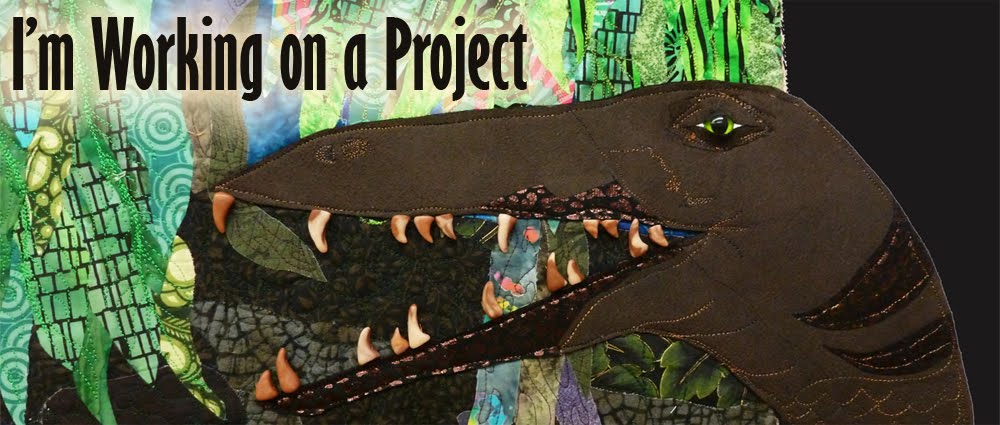The other bloggers sharing posts today are Terry and Bea, and I definitely encourage you to check their work out:
This years theme was "1 + 1 = 3", and my inspiring artist was Maria Oriza-Perez a contemporary abstract ceramicist from Spain. I've loved her work for a long time and her use of space, form, shape, and pattern really inspired my jump to dimensional fabric work in general. A lot of her work feels very mathematical, but she really uses non-traditional geometric forms to give what feels to me like a lot of motion to her work. In addition, I'm often inspired by the empty spaces and shapes created by her sculptures. Really really cool.
Anyone who's been following along here knows I've been working a lot with ways to introduce three-dimensional shapes and forms into my quilts, and several of the most recent (including this one) have been inspired by the concept of tesseracts. Mathematically, a tesseract is a 4th dimensional version of a cube, but its a concept I was introduced to in A Wrinkle in Time. There the idea is that a tesseract is a way of bringing two far away points in space and time extremely close together, to permit connections that would not be possible traveling through space and time normally.
Of course I only have three dimensions to work in rather than four, but I love the idea of finding different ways to make shapes by bringing together different spots on the surface of flat quilts. I've used a variety of techniques to do this, but recently have been using smocking.
I start by painting a large solid piece of fabric and backing, then layering and quilting. This one started out a solid gold-bronze color, and is a color scheme definitely outside my more common pink-purple-teal color palette. I free motion quilt, in this piece with 30 weight thread to help give some more interest to the surface, and then finish the edges with a facing made from the same painted fabric as the top.
After the quilting/piece is finished, I start sculpting using a standard smocking technique. This involves marking a grid on the back of the piece along with lines indicating points to be hand-stitched together. Finally, I built a frame to support the back of the piece since the newly created fabric folds and shapes kept wanting to flop all over the place!
Here's the final quilt, I named it Twining because the shapes and colors make me think of children's book illustrations of Jack and the Beanstalk.
 |
| Twining, c. 2018, Shannon Conley, 53" x 27" x 4" Photo: Mike Cox |
 | |
|
 |
| Twining, c. 2018, Shannon Conley, detail Photo: Mike Cox |
I hope you enjoyed seeing my piece, and please visit the other blog hop participants! I hope you'll come back here again, and if you're interested in more dimensional work, you can check out some of my other recent pieces.




Hi Shannon, what an amazing piece. It really is inspired by Maria Oriza-Perez's sculpture. Thanks so much for sharing your process with us.
ReplyDeleteYour piece is incredibly awesome, Shannon. Thank you for sharing.
ReplyDeleteRonelle
This piece is amazing!
ReplyDeleteSmocking a whole quilt!?! That's awesome! Love your piece, it doesn't even really look like a quilt anymore!
ReplyDeleteOh my that is amazing!!!!!
ReplyDeleteCool, I get photo credit. ��
ReplyDeleteI absolutely love this! The colors, the quilting and the effect from the smocking - incredible.
ReplyDeleteWhat an amazing piece! I have no idea how to smock anything, much less a quilt! Fantastic!
ReplyDeleteLove this!! Very unique! Very interesting and I enjoyed reading how you made it.
ReplyDeleteVery cool effect!
ReplyDeleteI love love love it, what a cool effect and the fabric and quilting are amazing. ty for sharing this with us.
ReplyDeleteThat is so cool! I love it!
ReplyDeleteWow! This is awesome. Thanks for showing how you did it.
ReplyDeleteSo glad I clicked on this link! What an intriguing piece. And I appreciate showing how you problem solved hanging it.
ReplyDeleteThis piece is simply FANTASTIC!
ReplyDeleteFabulous! Absolutely stunning!
ReplyDeleteDo consider entering this in SAQA's upcoming 3D exhibition, Shannon. You have hit something unique. Loved learning about your fascination with math. When you explain your process it looks so simple. But it is clear you had to problem solve every step of the way. It was worth it. Stunning.
ReplyDeleteMagnifique Bravo
ReplyDeleteWOW!! So extremely creative and inspiring!! Thanks for sharing your process, it is truly fascinating!!!
ReplyDelete